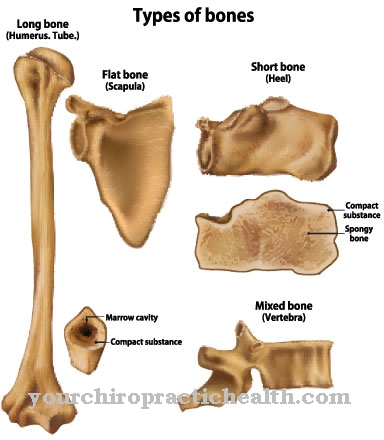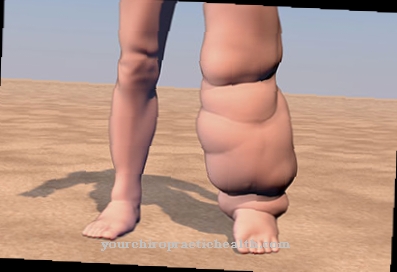Athlete's foot or Tinea pedis is one of the most common human diseases. It is a contagious fungal infection that, as the name suggests, occurs on the feet. The risk of athlete's foot increases when the skin is already slightly softened by water, sweat or other liquids. Athletes and people who do not rub the spaces between the toes dry after swimming, showering or exercising are particularly susceptible to athlete's foot or often get this fungal disease.
What is athlete's foot?

Athlete's foot is a very unpleasant disease, but basically completely harmless. The contagious fungal infection is accompanied by initially reddened, later oozing and finally itchy skin, which peels off and smells quite unpleasant.
In the further course of the disease, the skin can also tear in the affected areas and thereby cause pain, depending on the degree of the tear. In most cases, the athlete's foot sits between the toes, but it can also affect the soles of the feet, the tips of the toes and in individual cases the edges of the soles of the feet.
In general, in people with intact skin and an equally intact immune system, even if the athlete's foot is transmitted, ultimately no athlete's foot will develop from it. Athlete's foot can only spread to one's own body if a previously damaged skin or a reduced immune system creates the appropriate conditions.
causes
Athlete's foot is a fungal infection that is contagious and transmitted from person to person. Since every person repeatedly loses the smallest flakes of skin and unintentionally distributes them, skin particles of an infected person can get onto the skin of apparently healthy people and then infect them.
Skin material infected with athlete's foot can in principle be found in all places where people walk without shoes. For example, the risk of infection with athlete's foot in swimming pools, saunas, shower cubicles or public washrooms and shower rooms is generally very high. There is also a risk of athlete's foot infection in hotels whose rooms are carpeted. Even here, barefoot runners can become infected with athlete's foot if the carpet has not been thoroughly cleaned or disinfected.
Small foot injuries or cracks on the skin are also ideal targets for an infection with athlete's foot. Another cause of athlete's foot is permanent moisture on the feet, i.e. foot sweat. Therefore, people who often wear sneakers are particularly at risk. Other risk groups are people in whose families athlete's foot has occurred frequently, who suffer from circulatory disorders in the legs or who have a weakened immune system from the outset.
Symptoms, ailments & signs
A typical symptom of athlete's foot is severe itching between the toes. There the skin turns red and forms flakes of skin. The edge of the infected skin area becomes a little darker. In addition, small vesicles or pustules appear on this edge. The fluid-filled vesicles often combine to form larger bubbles.
After they burst, there is constant oozing. Movement causes pain in the affected areas. The moisture causes the skin to soften and crack, which increases the risk of bacterial infections. The skin appears whitish and peels off. The further the infection has progressed, the larger the dead skin cells become.
Another form of athlete's foot affects the cornea of the soles of the feet. This leads to additional cornification and flaking in dry skin. Since complaints rarely occur here, this form of athlete's foot is often not recognized as a fungal infection. However, painful cracks in the cornea can also occur.
As a rule, athlete's foot infestation is harmless and heals quickly after appropriate treatment. But there are also complicated courses with the infection spreading to the toenails. A fungal nail infection is much more difficult to treat and can lead to the peeling of the nail.
course
Athlete's foot initially manifests itself as reddened skin that is wet and itchy. An unpleasant smell is also a common side effect of athlete's foot infections. In the later course of the disease, the affected skin can crack and cause pain.
An inflammation of the skin can, but does not have to occur. Often it remains with weeping and foul-smelling areas of skin between the toes, which are sometimes accompanied by small blisters. In extreme cases, the athlete's foot can spread to other areas of the body that are also exposed to increased moisture, such as groins or armpits.
Typical complaints with athlete's foot are, in addition to the itching and burning sensation of the feet, the already mentioned moist and softened areas of the skin, which are known as maceration.
Complications
Although athlete's foot is generally considered harmless, complications are still possible. This is especially the case if the fungal infection is left untreated. There is therefore a risk that the fungus will spread to the toenails and cause a fungal nail infection.
The skin is affected by the fungal attack. Germs such as viruses and bacteria are given the opportunity to penetrate deeper into the layers of the skin, where they can cause further damage. An additional problem is that the athlete's foot can spread from the affected foot to other parts of the body, which is possible in any part of the body.
Just scratching the itchy foot with your fingers can be enough to cause the fungus to spread. There is a risk that the contagious parts of the fungus will stick under the fingernail. They then spread over the fingers into the face.
Other possible ways of spreading are towels or bathroom rugs that are contaminated by athlete's foot. If the patient dries himself off on other parts of the body such as the torso or ears with the used towel, the fungi can reach the affected areas.
The so-called superinfection is one of the most common complications of athlete's foot. Because the skin is pre-damaged by the athlete's foot, this harbors the risk that bacteria such as A streptococci may attack the affected areas and cause painful skin inflammation such as erysipelas.
When should you go to the doctor?
If the typical symptoms of athlete's foot infection are noticed, a doctor should be consulted. People who suffer from itchy spots or redness in the area of the feet are best to speak to their family doctor. Whitish discoloration between the toes is a typical sign of skin fungus.
If the symptoms mentioned occur after visiting a sauna or swimming pool, it is best to consult a doctor. People who do a lot of sport or who are confronted with unfavorable hygiene conditions at work should also seek medical advice if they suspect athlete's foot.
At the latest when severe pain and other complications set in, a doctor's visit is recommended. Medical clarification is necessary solely for reasons of the risk of infection. Athlete's foot can usually be treated with home remedies and drugs from the drugstore, but the disease should be diagnosed at least once. Patients who have suffered from athlete's foot for a long time, which cannot be treated by the usual means, should visit a specialist clinic or a dermatologist.
Doctors & therapists in your area
Treatment & Therapy
If the athlete's foot does not have inflammation or if it has already subsided, it makes sense to use a fungus agent to apply it (antimycotic). The fungus remedy must be applied for at least two to three weeks, even if the symptoms have subsided and the patient has the impression that the athlete's foot has disappeared.
In the case of severe inflammation caused by athlete's foot, the feet should be cleaned in a disinfecting potassium permanganate solution. Spreading a lotion on the affected areas that contains zinc oxide, talc, glycerin and water and has a drying and cooling effect is also an effective remedy.
Disinfectants should no longer be used if athlete's foot has already occurred, otherwise contact eczema can easily occur.
↳ More information: Home remedies for athlete's foot
prevention
Dry feet are the best way to prevent athlete's foot. After bathing, the feet should always be dried thoroughly, especially between the toes. In addition, only socks and stockings made from natural materials should be worn. You can go barefoot, but you should avoid carpets or bathroom mats in hotels.
Aftercare
Athlete's foot can be very persistent, especially in diabetics. In this respect, both preventive and follow-up measures must be observed. Careful aftercare is also precaution. One could almost speak of a widespread disease that preferentially spreads through a damp environment.
Medical compression stockings and functional socks with a synthetic content are beneficial for athlete's foot. In addition, sports shoes with a membrane should not be worn during the follow-up period, as these also require the wearing of synthetic socks. Otherwise the functions of the membrane will not be fully utilized.
Careful foot care is one of the possible aftercare measures after a foot or nail fungus. The feet should only be washed and creamed briefly, but if possible daily. Avoid damp areas between the toes.
Since athlete's foot with its mycelia also grows under the skin, it is important to watch out for a new infestation elsewhere. The worn stockings should be disinfected after athlete's foot treatment. The same applies to all towels that were used during the treatment.
Fungal spores have a long survival time. They can be stored in carpets and shoes and cause a new infection. Therefore, during the aftercare phase, it is wise to disinfect all shoes worn during the fungal treatment. The immune system should be supported if necessary. Shoes that are too tight should be avoided in the future. They favor athlete's foot colonization.
You can do that yourself
Various measures can be taken in everyday life to protect yourself from athlete's foot. Protective clothing should always be worn on the feet in public baths or under the showers. In areas where many people move barefoot and there is moisture on the floor, it is necessary to protect the feet in order to avoid infection with the germs. Flip-flops or open sandals that are made of rubber-like materials and are therefore water-repellent have proven their worth.
In addition to protective clothing, your own feet must be kept dry after showering or bathing. If you tend to perspire heavily on your feet, you should also use care products. Powder or powder-like products can be applied to ensure adequate protection against moisture.
In addition, attention should be paid to cracks or damage to the skin on the feet.Since germs enter the organism through the open wounds, they have to be adequately protected from intruders. Plasters, bandages or protective stockings should be used for this. The damaged regions should also be kept away from public baths or showers until they have healed.
Since athlete's foot is highly contagious, additional precautions must be taken to ensure that no other people are infected. To do this, it is necessary to wear protective stockings in private or public pools.

.jpg)











.jpg)

.jpg)
.jpg)











.jpg)